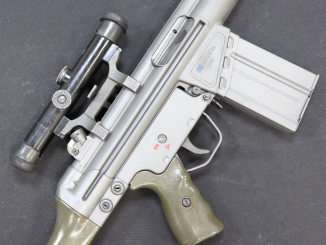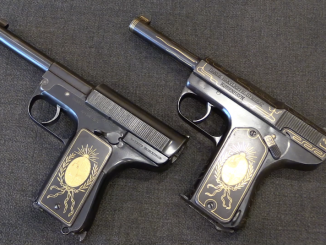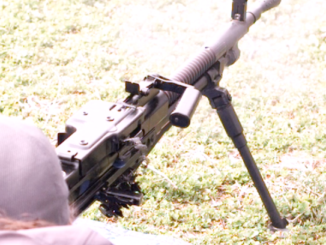Development of the weapon that would eventually become the very successful 1902 Madsen light machine gun began many years earlier, in 1883. Two Danes, Madsen and Rasmussen, began working on a recoil-operated self loading rifle design that year, with Madsen developing the idea and Rasmussen fabricating the actual pieces. The project was made difficult by the black powder cartridges available at that time (black powder fouled intricate mechanics quickly, and also created a relatively poor recoil impulse compared to later smokeless powders), but by 1887 they had a workable gun completed. This rifle, designated the M1888 Forsøgsrekylgevær, was entered into Danish military testing, and went so far as to have 50 rifles field-tested by a battalion of troops. The conclusion was that the design wasn’t good enough for infantry use (although it was considered for fortress use, which would presumably be a cleaner environment that being in the hands of field infantry units), and the Krag-Jørgensen was selected instead for general issue.
Note the very small bayonet, typical of recoil-operated rifles in which too heavy a bayonet will cause the rifle to malfunction by increasing the weight of the reciprocating barrel assembly (the M1941 Johnson rifle was also recoil operated and used a similar style bayonet). As testing progressed, stacking swivels were added to the guns.
Many thanks to the Tøjhusmuseet (Royal Danish Armory Museum) for letting me have access to this very rare rifle!




“M1888 Forsøgsrekylgevær”
So if anyone wants steam-punk self-loading rifle this seems to be good answer.
Interestingly not away from Denmark, some time earlier, in 1870, Friberg created machine gun:
http://peashooter85.tumblr.com/post/108124336697/the-first-true-machine-gun-the-kjellman-light
I am wondering if Madsen or Rasmussen were aware of that development.
“Madsen light machine gun”
If you are interested in that, I hope you will that document:
TRIALS WITH THE MADSEN MACHINE GUN MODEL 1930 FIRING THE BRITISH .303 SERVICE CARTRIDGE
WITH LIGHT „ALFA“ BARREL
https://sassik.livejournal.com/498166.html
interesting, it shows that THE DANISH RECOIL RIFLE SYNDICATE promoted concept of general-purpose machine gun (which they called STANDARD MACHINE GUN) yet back in 1930.
“very successful 1902 Madsen light machine gun”
It was so successful that knock-off appeared as early as 1905, under name Rexer
http://guns.wikia.com/wiki/Rexer
it was produced in Great Britain until 1910, when it was found to infringe Madsen patents.
I’ve heard conflicting accounts from different sources as to whether or not Rexer was simply a shell company belonging to DRS or whether it was an independent company that produced Madsens under license.
One sources posits that Rexer went under because they tried to juggle the manufacture of motor cars and small arms, which proved too costly.
Another source claims Rexer fell apart because their self-loading rifle prototype, which was tested by the British Automatic Rifle Committee, infringed Madsen’s patents and they were promptly sued out of business by DRS.
I’ve also heard it said that DRS actually designed the Rexer self-loading rifle, and simply used Rexer as an organ to market it. This assumes the former case, that DRS owned Rexer.
Here’s Rexer’s semi-auto prototype, said to be derived from the Madsen: https://78.media.tumblr.com/954a6b05d47d17281dde078b07f147f1/tumblr_ntekg1uF671rbp0ifo1_1280.png
A very curious gun, it’s too bad it doesn’t cycle what with the handy hinged side plate and great view. One piece that I find interesting is the pivot pin for the cam tracks. It is the pin with the “oval” head set in the triangular milled out area at the rear of the frame. If someone told me it was a keyed disassembly pin I’d fall for that. The head is kind of bent to provide some tension. Also there is a circular scratch on the milled area. I would expect the scratch to be deeper if it was caused by the gun being fired many times and not disassembled occasionally. The whole point of the above is that when the cycling lever stops moving, it is lined up with the head of the pin. If indeed it was a keyed pin the up position is where you could pry it out and the down position would be locked. Is this the culprit for not cycling? I would fiddle with it.
Would that explain the movement of the charging lever during recoil? Would not expect that to reciprocate with the action.
Ian deliberately opened the lever before simulating recoil. My take is that the recoil spring becomes disconnected from the action to make it easier to simulate recoil. In real life this would make it easier to cycle the gun manually. When the lever is closed the front half may pivot independently, but opening the lever may engage both halves so they act like one piece.
The falling block loading system is very similar to that of Spencer’s shotgun, albeit upside down. At one time I had a Bannerman built example.
The fixed stripper clip is intriguing, and could be the solution to the woes of California, New York, and Connecticut.
Sure, that would bypass the detachable magazine limit, but the lawyer would argue that a fixed clip would essentially be a “bottomless magazine” so long as you could pile ammunition into it however long you wanted. “There’s no magazine-changing period if all one needs to do to load is drop bullets into the area above the breech. Therefore a ‘fixed clip’ is nothing more than a sly way to turn a semiautomatic rifle into a machine gun.” That argument relies on the fact that the action doesn’t have to be open or inoperative while loading. Remember that the vertical stack feeding systems were used on the Gatling, Gardner, and Nordenfelt guns. While they weren’t automatic, they were rapid-fire weapons!
They’re the idiots who said we have to have a fixed ammunition feeding device. It’s a fixed ammunition feeding device – bastards didn’t say it couldn’t be open ended. It only holds 10 rounds @ any given time.
if soldiers complained about the holes in the magazine of the chauchat they would have loved this one!
Good morning from Spain
reading your article, I have a question, is it really the first attempt at a semi-automatic weapon?
I send you some photographs of a French rifle, 8mm lebel, which includes a semiautomatic firing system, and I understand that it may be earlier than that of the article.
without more than congratulating him after his magnificent work he says goodbye
Jorge I. Fdez.
How can I send you some pictures?